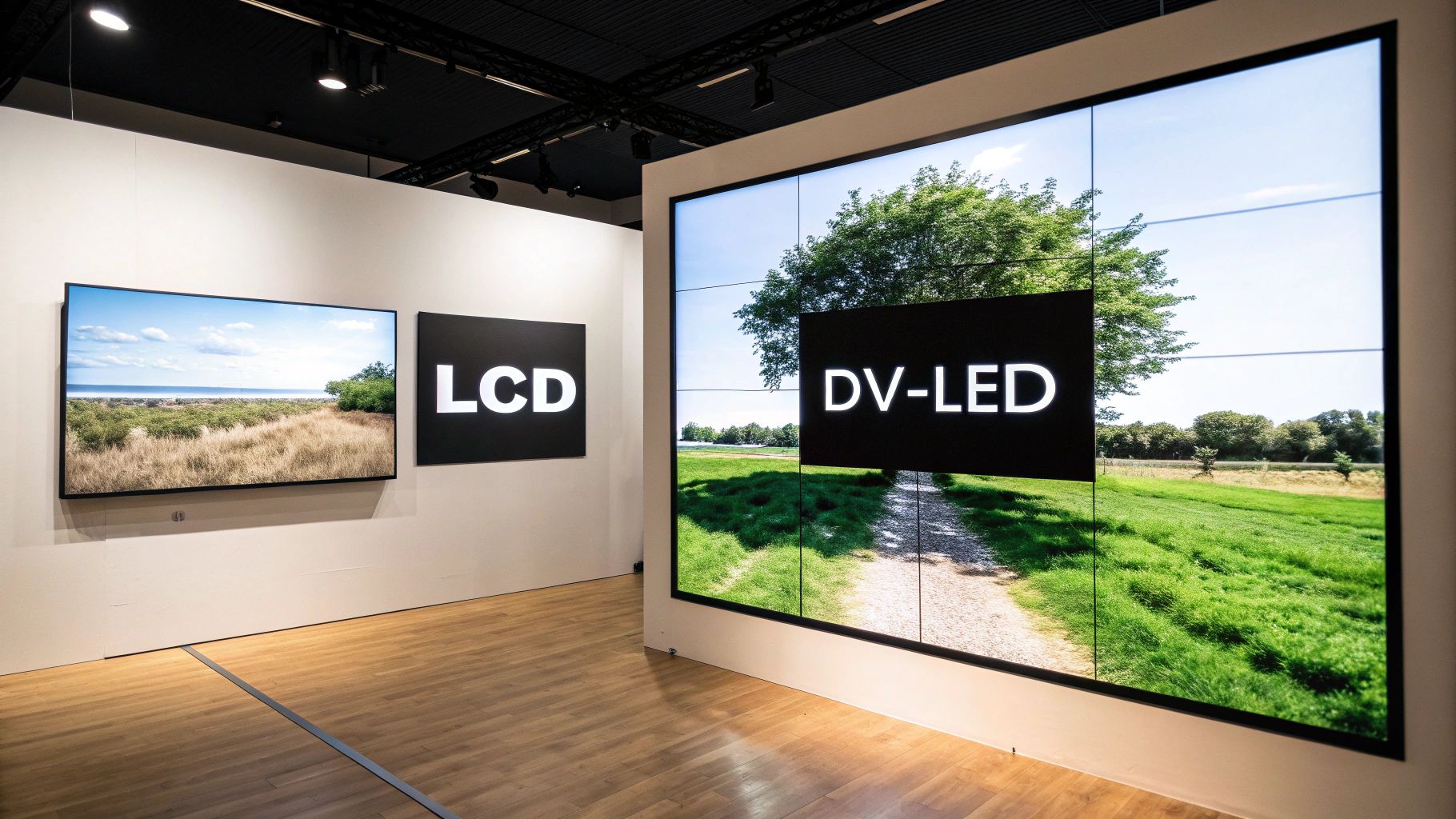
Your Guide to the Best LED Panel for Video
So, what exactly is a professional led panel for video? Think of it less like a traditional TV and more like a high-tech, luminous building

When you're looking for a massive, high-impact display, an LCD video wall is often the first technology that comes to mind. It's a proven workhorse, known for delivering incredible resolution without breaking the bank. These systems are created by tiling multiple commercial-grade LCD panels together, creating one giant, cohesive screen that’s perfect for indoor spaces where every detail matters.
Think of an LCD video wall as something far more robust than just a bunch of TVs slapped on a wall. Each panel is a purpose-built commercial display, engineered to run for thousands of hours without a hiccup. The core technology uses a layer of liquid crystals, which are lit up by a powerful backlight. By precisely controlling the light that passes through those crystals, each panel produces the crisp, high-definition images demanded by professional environments.
There's a good reason this technology is a staple in mission-critical control rooms, sleek corporate lobbies, and modern retail stores. It offers a straightforward path to stunning 4K or even 8K resolutions at an initial cost that’s often much lower than other large-format options. But to really know if an LCD video wall is the right call for your project, you need to understand the specs that define its performance.

Getting a handle on a few core metrics is essential when evaluating any LCD video wall. These numbers directly translate to the real-world viewing experience and will tell you if a particular setup is right for your space.
The secret weapon of an LCD video wall is its pixel density. If your content involves sharp text, complex schematics, or detailed graphics meant for close-up viewing, the high resolution of LCD panels is an undeniable advantage.
To really put LCDs into perspective, it helps to see how they compare to their biggest rival: Direct View LED (DV-LED). While both technologies are used to create huge digital displays, they get there in fundamentally different ways, which leads to different strengths.
| Feature | LCD Video Wall | Direct View LED (DV-LED) |
|---|---|---|
| Visual Cohesion | Visible (but minimal) seams from bezels | A truly seamless, single canvas |
| Ideal Viewing | Better for closer distances due to high resolution | Best from farther back (unless you pay for fine pitch) |
| Brightness Level | Great for indoors (500-700 nits) | Extremely bright (800+ nits), ready for outdoors |
| Initial Cost | More affordable, especially for HD/4K | Higher upfront cost, particularly for fine pixel pitch |
| Best Environment | Indoor spaces with controlled lighting | Bright indoor venues and any outdoor setting |
With this foundation, you can start to see where an LCD video wall really shines. The final decision always comes down to balancing your specific needs—like viewing distance, ambient light, and budget—against what each technology does best.
Choosing the right video wall isn't about picking the shiniest new toy. It’s a strategic decision that demands a clear, structured game plan. Before you even think about specific brands or panels, you need a framework that lines up with your business goals, the realities of your physical space, and your budget. Getting this right means moving beyond a simple spec sheet to make a smart choice that pays dividends for years.
The whole process starts by asking: what does a successful project actually look like for us? Are you trying to create a jaw-dropping visual centerpiece for your corporate lobby? Or maybe you need razor-sharp data visualization in a mission-critical control room. Each of these goals puts a different set of technical and operational features at the top of the list.
Nailing down these core factors will give you the confidence to figure out if an LCD for video wall system—or something else entirely—is the right fit. It's a crucial first step in a market that's absolutely exploding. Right now, the global video wall market is valued at around USD 10.24 billion, and it's on track to hit an incredible USD 27.8 billion by 2035. That growth tells you just how much businesses are relying on this technology. You can dive into more market projections and analysis to see the trend for yourself.
To help you get started, here’s a quick overview of how the main video wall technologies stack up against each other.
This table gives you a high-level snapshot of the core strengths and weaknesses of today’s leading video wall solutions. Think of it as a cheat sheet to quickly see how LCD, Direct View LED, and older projection technologies compare on the metrics that matter most.
| Technology Feature | LCD Video Wall | Direct View LED (DV-LED) | Rear Projection Cube |
|---|---|---|---|
| Bezels/Seams | Ultra-narrow bezels create minimal seams (as low as 0.44mm) | Completely seamless, monolithic image | Visible seams between cubes, typically wider than modern LCDs |
| Image Quality | Excellent pixel density (4K per panel), great for close viewing and detailed content | Exceptional brightness and contrast; pixel pitch determines optimal viewing distance | Lower brightness and contrast; best in controlled lighting conditions |
| Brightness | High (500-700 nits), ideal for most indoor environments | Very high (1,000+ nits), suitable for bright indoor and outdoor use | Low to moderate, struggles in high ambient light |
| Cost (Initial) | Lower upfront hardware cost, most budget-friendly option | Higher initial cost, especially for fine pixel pitch models | Moderate to high initial cost |
| Lifespan/Maintenance | 50,000-60,000 hours; individual panel replacement is straightforward | 100,000+ hours; module-level repairs are possible | Lamp-based systems require frequent replacement; laser models offer longer life |
| Power/Heat | Moderate power consumption and heat output | Higher power draw and heat, requires robust thermal management | Lower power consumption compared to DV-LED |
| Best Use Cases | Control rooms, corporate lobbies, retail, meeting rooms, budget-conscious projects | Large-scale venues, broadcast studios, high-end retail, outdoor advertising, premium lobbies | 24/7 control rooms (legacy), crisis management centers where bezels are less critical |
While tables are great for a quick look, the devil is always in the details. LCD, for example, often hits the sweet spot for a huge range of indoor applications where pixel-perfect clarity up close is more important than a completely seamless canvas. Let’s break down the key decision factors a bit more.
At the end of the day, a video wall’s job is to deliver a stunning visual experience. But "image quality" is a lot more than just a resolution number. It’s a mix of factors that have to work together to create a powerful, cohesive picture.
First up is resolution density—how many pixels are packed into the screen. This is where LCD panels really shine, with most offering native 1080p or even 4K resolution right out of the box. When you tile these together, you get an incredibly high-resolution canvas that’s perfect for showing fine text, complex schematics, or gorgeous video content meant for close-up viewing.
Then you have color gamut and accuracy. This is all about how true-to-life the colors on the screen are. If you're showcasing a brand or a product, getting the colors exactly right isn't just a "nice-to-have"—it's a must. You'll want to look for panels that cover specific color spaces like sRGB or DCI-P3 to make sure what you see on the wall is exactly what you designed. Contrast ratio—the gap between the deepest black and the brightest white—is also a huge part of what makes an image pop with depth and energy.
A video wall isn’t just a screen; it’s a permanent fixture that has to fit perfectly into your space. The physical design of the panels themselves will have a huge impact on how complex the installation is and what the final product looks like.
The bezel-to-bezel gap is probably the most defining trait of an LCD for video wall. Today's ultra-narrow bezel models have shrunk this seam down to less than a millimeter, but it's still a factor you have to account for, especially if your content is designed to flow seamlessly across multiple screens.
While a tiny seam exists, the trade-off for an LCD video wall is exceptional pixel density at a lower cost. For many indoor applications, this balance provides the ideal blend of performance and value.
Beyond bezels, you need to think about other physical realities:
A smart investment is about more than just the sticker price. To get the real financial picture, you need to look at the Total Cost of Ownership (TCO), which covers every expense you'll have over the video wall's entire lifespan.
This starts with the upfront hardware and installation costs, but it also has to include the ongoing operational bills. Energy consumption is a big one; a large video wall running all day can make a real dent in your utility budget. You also need to plan for potential maintenance and repair costs, because different technologies have very different lifespans and service needs. By thinking in terms of TCO, you can make sure your video wall remains a valuable—and financially sustainable—asset for years to come.
When you're looking at large-format displays, the conversation almost always lands on two key players: high-resolution LCD for video wall systems and the brilliantly seamless Direct View LED (DV-LED). While both can create jaw-dropping visual canvases, they get there in fundamentally different ways. This makes each one a better fit for certain spaces and goals, and understanding those differences is crucial.
This isn't just an academic exercise—the choice matters more than ever. The video wall market exploded between 2013 and 2020, growing from USD 4.12 billion to an estimated USD 17.96 billion. That’s a staggering 23.44% compound annual growth rate, largely fueled by the shift to digital signage where LCDs offered a potent mix of sharp resolution and flexible setups.
Now, let's get into what really separates these two technologies.

The first thing you'll notice is the seams—or lack thereof. An LCD video wall is a mosaic of individual panels, and each panel has a physical border called a bezel. Modern engineering has shrunk these bezels down to less than a millimeter, but you can still see the grid, especially when content spans across multiple screens.
On the other hand, DV-LED walls are built from smaller modules that fit together perfectly, creating a single, uninterrupted visual surface. There are no gaps, no lines, no distractions. This makes DV-LED the hands-down winner for immersive experiences where any break in the image would ruin the effect.
Key Differentiator: If you need one massive, continuous digital canvas for high-impact storytelling, DV-LED's seamless design is a massive advantage. But for control rooms or presentations where content is often boxed into individual screens anyway, the tiny seams on a modern LCD are a perfectly reasonable trade-off.
This is where things get really interesting, and where the strengths of an LCD for video wall truly shine. LCD panels have a fixed, high native resolution—usually Full HD (1920×1080) or even 4K (3840×2160) per panel. This density of pixels means they're incredible at showing fine details, crisp text, and complex graphics, even if you’re standing just a few feet away.
DV-LED's resolution is all about its pixel pitch—the tiny distance between the center of each LED. A smaller pixel pitch (like 1.2mm) gives you a higher resolution, but the cost goes up significantly. A larger pitch (say, 3.9mm) is more budget-friendly, but you need to stand farther back, or the image will look blocky.
Where you plan to put the wall plays a huge role. LCD video walls are champs in controlled indoor lighting. With brightness levels typically between 500 to 700 nits, they produce rich, clear images in offices, conference rooms, and most stores.
But put an LCD in a sun-drenched atrium or an outdoor space, and it can look washed out. This is where DV-LED comes in. Its brightness often starts at 800 nits and can go much, much higher for outdoor models, easily cutting through direct sunlight to deliver a vibrant, saturated image in almost any condition. You can see just how powerful they can be with examples like this 216" DVLED video wall display.
For a lot of us, it all comes down to the budget. The upfront cost of an LCD for video wall is almost always lower than a DV-LED wall of a similar size and resolution. This makes LCD a very compelling option if you need to cover a lot of visual real estate without breaking the bank.
But don't stop at the initial price tag. DV-LED walls often have a longer lifespan, with many rated for over 100,000 hours of use, compared to the 50,000-60,000 hours for a typical commercial LCD. They can also be more power-efficient per nit of brightness, though their much higher peak brightness can mean they use more power overall.
When you think about the total cost of ownership (TCO), you have to weigh a few things:
Ultimately, picking between LCD and DV-LED is about matching the right tool to the job. An LCD gives you incredible detail up close for a lower initial cost, making it ideal for information-heavy indoor spaces. DV-LED delivers a seamless, super-bright canvas that dominates in large, bright environments where the main goal is to create an unforgettable immersive experience.
A video wall is so much more than what you see on installation day. The real story unfolds over months and years of operation, and that’s where the true costs and headaches can emerge. When you’re deciding between LCD and DV-LED, you’re not just choosing a screen; you’re choosing a long-term relationship with its power bills, maintenance needs, and aging process.
Digging into these practical, day-to-day realities is what separates a smart investment from a future problem. Let's break down what ownership really looks like.
Every big screen eats power and spits out heat, but LCD and DV-LED do it very differently. On paper, an LCD for video wall system often looks like the more efficient choice for a typical indoor space. Panel for panel, it generally draws less power than a DV-LED wall running at a comparable brightness.
But power draw is only half the story. The heat these panels produce is a huge deal. LCDs generate a steady, moderate heat that needs to be vented, especially if they’re boxed into a tight space or running 24/7 in a control room. If you don't manage that heat, you’re looking at a shorter lifespan and wonky performance.
DV-LED, especially the super-bright outdoor kind, is a different beast altogether. It can be a serious power hog and generate a ton of heat. For a massive installation, you absolutely have to factor this into your building’s HVAC plan. The extra cooling requirements can have a real impact on your utility bills. It's a critical piece of the puzzle, especially when you start looking into the complete outdoor LED sign cost.
An LCD wall might have a lower power rating on the box, but you have to think about the entire thermal ecosystem. A full energy audit should include the cost of cooling, not just the cost of running the displays themselves.
What happens when something goes wrong? This is where the two technologies couldn't be more different, and it has a massive impact on downtime and your wallet.
An LCD video wall is basically a grid of TVs. If one panel dies, you have to replace the whole thing. It’s a pretty simple swap, but it’s a big, expensive part. The real kicker? A new panel from a different batch might not perfectly match the color and brightness of its older neighbors, creating a frustrating patchwork effect.
Here’s a quick breakdown of how you’d service each:
That modular design gives DV-LED a huge leg up. On top of that, DV-LEDs just last longer. We're talking lifespans rated for 100,000 hours or more, which completely blows away the 50,000 to 60,000 hours you typically get from a commercial LCD. Over the long haul, that means fewer replacements and a better return on your investment.
Keeping that giant, seamless image looking perfect is an ongoing job. Both technologies need a good calibration right out of the box, but they age in very different ways.
With an LCD for video wall, each panel is its own little world with its own backlight. After thousands of hours, those backlights start to fade, and they don't all fade at the same rate. This can lead to a subtle (or not-so-subtle) checkerboard of slightly different colors and brightness levels. To fight this, you need to bring in special sensors to recalibrate the wall regularly and force everything back into uniformity.
DV-LEDs have their own aging process, where individual LEDs can shift in color over their long life. But the fix is far more elegant. Advanced calibration systems can map the performance of every single module, allowing the software to make tiny adjustments on the fly. This granular control keeps the entire wall looking perfectly uniform for much, much longer. It's a commitment, but it's what ensures your investment looks as stunning on year five as it did on day one.
Technical specs on a sheet of paper are one thing, but the real magic happens when the right technology meets a specific, real-world purpose. The "best" video wall isn't the one with the highest numbers; it's the one that perfectly fits your goals, your environment, and your budget. This is where we move from theory to practical application.
The entire video wall market, which includes both LCD and LED, has exploded in recent years. It's projected to climb to nearly USD 27.8 billion by 2025, largely because businesses are finally realizing the incredible impact of matching the display to the mission.
Let's walk through four common scenarios to see how an LCD for video wall really stacks up against the alternatives.
In a boardroom or huddle space, the name of the game is clarity and detail without breaking the bank. Presentations are full of dense data, fine-print text, and detailed spreadsheets that have to be perfectly legible for everyone, even the person sitting right up front.
This is the quintessential home turf for an LCD video wall. The incredible pixel density of individual 1080p or 4K panels keeps content razor-sharp, even at close viewing distances. Sure, you'll have barely-visible seams, but that's a tiny trade-off for the exceptional detail and significantly lower upfront cost compared to a fine-pixel-pitch LED wall.
Best Fit: LCD Video Wall
For most corporate environments, LCD is the clear winner. The combination of high resolution for detailed content, spot-on color accuracy for branding, and a much friendlier cost-per-pixel makes it the logical choice.
Retail is a battlefield of impressions. Sometimes you need immersive, brand-defining visuals, and other times you need to communicate hard product information. For that stunning, seamless "wow-factor" display right at a store's entrance, a DV-LED wall is simply unbeatable. With zero bezels, it creates one massive, uninterrupted canvas that can completely transform a physical space.
But when you move into the aisles for interactive kiosks or displays showing product specs and pricing, an LCD for video wall system becomes the more practical tool for the job. Its high resolution makes text and fine graphics pop, and the lower cost means you can deploy more of them throughout the store without blowing your budget.
Here’s a quick breakdown for retail:
When you're running a 24/7 mission-critical operation like a security center or network monitoring room, reliability and information clarity are everything. Operators are staring at multiple data streams, maps, and video feeds for hours on end, and they can't afford to miss a single detail.
LCD video walls have been the industry standard here for a long time, and for good reason. Their high resolution allows dozens of sources to be tiled across a single canvas without losing legibility. They also excel at displaying static content for long stretches with minimal risk of burn-in, and the technology is proven to be exceptionally reliable. Understanding the technology's role is key; for example, learning the best practices for virtual events shows how dynamic displays are crucial for engagement, a principle that directly applies to keeping operators informed in a control room.
This chart really drives home how different long-term costs play into the decision.

As you can see, the initial purchase price is just the beginning. Ongoing costs for power and maintenance dramatically shape the total cost of ownership over the display's entire life.
For the big leagues—concert venues, stadiums, airports, and public squares—the decision almost always swings hard to DV-LED. In these environments, people are viewing from far away, and the screen has to be bright enough to compete with stage lighting or even direct sunlight.
There's really no other choice. DV-LED technology is the only solution that can deliver. Its modular nature allows you to build colossal screens of any shape or size, and its insane brightness levels (often well over 1,000 nits) can slice right through the harshest ambient light to deliver a punchy, vibrant image. An LCD is a fantastic indoor tool, but it just can't compete with the raw power and scale needed for these massive environments. If you're looking into this area, our guide on digital outdoor signage dives deeper into these powerful solutions.
To round things out, let's tackle the most common questions that pop up when people are deciding on an LCD for video wall projects. Think of this as the final checklist to make sure you're moving forward with total confidence.
This is a great question because it gets right to the difference between professional and consumer gear. Commercial-grade LCD panels are built like tanks, rated for 50,000 to 60,000 hours of continuous operation.
To put that in perspective, that’s over five to seven years of running 24/7. Your living room TV just isn't designed for that kind of marathon. These professional displays have built-in tech to prevent burn-in and manage heat, ensuring they perform reliably day in and day out in demanding environments.
That gap is all about the "bezel-to-bezel" width. It's simply the combined thickness of the borders from two panels sitting side-by-side. So, if you're looking at a modern panel with a razor-thin 0.44mm bezel, the seam you'll actually see is just 0.88mm wide.
It might sound like a tiny detail, but it’s a huge deal for the overall look.
When your content is designed to flow across multiple screens—like a massive data visualization or an immersive video—a tiny bezel-to-bezel width is non-negotiable. It helps the individual screens melt away, creating a fluid, cohesive image instead of a distracting grid.
I get asked this a lot, and my answer is always a firm "no." While it might seem like a clever way to save a few bucks, using consumer TVs for a professional video wall almost always ends in frustration and a subpar result. They’re missing the key ingredients.
Here’s what you give up:
In the end, it’s a shortcut that completely undermines the goal of creating a seamless, impressive display.
Think of color calibration as the final, essential step that brings the entire wall together. It’s the meticulous process of fine-tuning each and every panel so they all match a single, uniform standard for color and brightness. Without it, your LCD for video wall won't look like a single canvas.
If you skip this, you’ll see distracting variations from one screen to the next, shattering the illusion of a single, massive display. It makes the whole setup look disjointed and amateurish. Professional installers use special sensors and software to dial in every panel perfectly, guaranteeing that the entire wall is a single, flawless image. It’s the difference between "good enough" and "truly professional."
At Smart LED Inc., we live and breathe this stuff. We’re here to provide expert guidance to help you choose, design, and install the perfect high-impact visual solution for your business, venue, or home theater. Our factory-direct approach means you get the best value without ever compromising on quality or support.
Ready to transform your space? Explore our indoor and outdoor LED solutions today!

So, what exactly is a professional led panel for video? Think of it less like a traditional TV and more like a high-tech, luminous building

When you're looking for a massive, high-impact display, an LCD video wall is often the first technology that comes to mind. It's a proven workhorse,

So, you're wondering about the real cost of putting an ad on an LED billboard. The short answer? It can run anywhere from $1,200 a
"*" indicates required fields